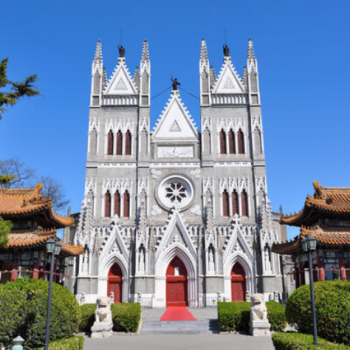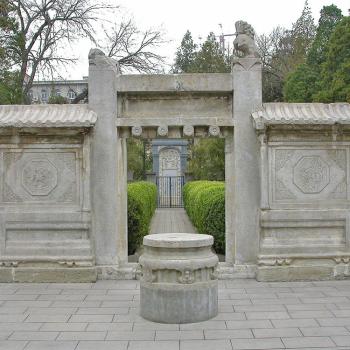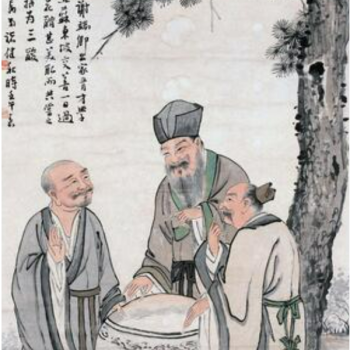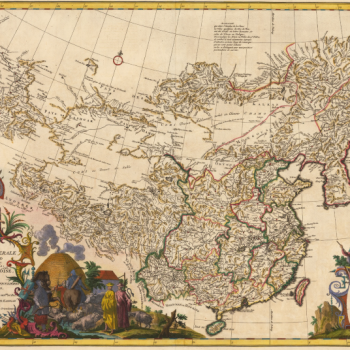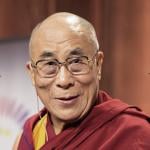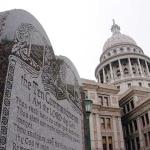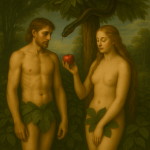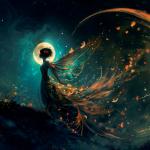
As the Ming era wound down, the Three Ages sects continued to evolve. There was never stagnation; the doctrines and theological vision common to most sects continued to develop and change. But there was also always continuity; the same distinctive complex of ideas—the Three Ages, the Venerable Mother who is also the Primordial Buddha, the return to the Native Place—held sway even as the concepts evolved and the details sometimes changed.
The last decades of the Ming also saw the sects increasingly become a thorn in the side of the government. The vast majority of sects at the time were peaceful, content to bring about the new world by preaching and conversions rather than through violent means. Often, they did their best to accommodate themselves to the ruling powers-that-be. Only the Hongyang jiao ever succeeded at this but not for lack of trying on the part of the other sects; recall how the baojuans traditionally included a wish of long life to the reigning emperor. This has at times needlessly puzzled Western scholars, who are often overly beholden to Norman Cohn’s portrait of millenarians as antisocial, world-rejecting revolutionaries. But there is no need for confusion. Even in the West, millennialist movements have often had to make their peace with living in the present world even as they awaited the next one. That was a feature, and not a bug, of Joachim’s vision, which expected the world to enter into the millennial age without losing many of the things that currently define it, as Marjorie Reeves notes in The Influence of Prophecy in the Later Middle Ages when she says that “[t]he third status is within history, yet not a third set of institutions, rather a new quality of living which transforms former institutions” (Reeves 303). Despite their sometimes fantastical language, the Ming sectarians seem to have had a similar outlook and saw no issue with the worldly authority of the emperor continuing into the new age.
Thus, most sects were content to live under the current system as long as it did not persecute them. And the Ming government was usually just as content to look the other way as long as they did nothing to bring themselves to the authorities’ attention, which sects generally did by growing too large or becoming too famous or amassing too much wealth. If a sect could avoid doing those things, it tended to be safe, and an equilibrium was maintained that, on the whole, benefited both sides.
This began to change in the final decades of the Ming. Suddenly, the Three Ages sects begin to rise in rebellion with greater frequency. In 1606, a native of Jiangsu—another of those provinces where something apocalyptic always seemed to be going on—named Liu Tianxu declared himself to be Maitreya and started planning to overthrow the government. He seems to have brought together a number of millennialist traditions, for he also made use of the old prophecy that the messiah would bear the surname Li by declaring “‘King Li will appear’ (Li wang chushi 李王出世)” (qtd. in Seiwert 291). Given his own surname and messianic sense of self-regard, perhaps he was recalling the even older prophecy that the savior would be named Liu and Li would be his helpmate.
Regardless, the basis of his teaching was the Three-Ages doctrine. As Hubert Seiwert says in Popular Religious Movements and Heterodox Sects in Chinese History, “Liu Tianxu did not rely only on oral lore. He used a book with the title Huangji shouyuan baojuan … This was either the Huangji jieguo baojuan, which was also known as Shouyuan baojuan, or the Jiulian baojuan, whose alternative name was Huangji juan” (Seiwert 291). Whilst calling himself Patriarch of the Wuwei Teaching, just as Patriarch Luo and Puming had before him, he also took on a more messianic title. As Seiwert relates, “Liu Tianxu also declared himself to be a manifestation of the Huangji fo 皇極佛 (Buddha of the August Ultimate). Both the Huangji jieguo baojuan and the Jiulian baojuan use the expression huangji to refer to the age ruled by Maitreya” (291). Thus, Liu showed himself to be a careful student of the early and foundational baojuans, using their terminology and ideas about the Three Ages to justify his claims. And while Ming authorities had no trouble putting down his rebellion, killing Liu himself in 1607, the situation certainly demonstrated that the baojuans which had been largely ignored by government authorities for two centuries contained radical ideas, which in the right hands could be put to more dangerous and revolutionary purposes.
This point was driven home more forcefully in 1622, when the Ming Dynasty faced the largest millenarian rebellion in its history. The roots of that rebellion also ran back to a man named Wang Sen. Wang Sen was a highly influential sectarian leader from Zhili. The sect he founded was named the Dacheng jiao (大乘教—Great Vehicle Teaching) or the Hongfeng jiao (弘封教—Vast Seal Teaching) but was popularly called the Wenxiang jiao (聞香教—Incense Smelling Teaching). Wang Sen adopted the organizational techniques and structures pioneered by Yin Ji’nan and Yao Wenyu and applied them with great success in the north, managing to build a religious infrastructure rivalling theirs in size, which, as Seiwert puts it, “extended to six provinces as far as Sichuan, with a membership of over two million” (377). However, Wang’s authority proved insecure, as a large number of followers under the leadership of Li Guoyong broke away to form their own sect in 1612. The resulting hostility between the two sects erupted into violence, which alerted the Ming authorities to their existence and triggered a crackdown in 1614. Wang was apprehended and sentenced to death, finally meeting his end five years later in 1619.
If the Ming government believed that these actions would suppress the Dacheng jiao and bring an end to their existence as a substantial sectarian organization, resulting events dashed those hopes. After Wang’s death, the sect came to be jointly ruled by his son Wang Haoxian and by an individual named Xu Hongru. With Wang’s tacit support, Xu Hongru rallied the Dacheng jiao to war. In 1622, he launched what has become known as the Dacheng rebellion. Recalling the religious rebellions of old—it even fortuitously shared its name with one of the greatest millennialist uprisings of medieval China, the sixty-century Dacheng revolt undertaken by Faqing—this insurrection also looked forward to the Bagua rebellion that would so bedevil the Qing Dynasty some two centuries later.
In a culture that largely subscribed to a cyclical view of time, it must have seemed like a full-circle moment for the Ming. The dynasty owed its own establishment to a successful millennialist rebellion and now another rebellion of a similar nature was threatening to overturn the Ming and put a new dynasty in its place. For indeed, that threat was very real. Zhao Yan, the government official tasked with curbing the rebellion, proclaimed that it was the “most serious crisis in the dynasty’s two-hundred and sixty-year history” (qtd. in Seiwert 379). Despite losing several cities to the rebels, however, the Ming was finally able to defeat the Dacheng forces and execute both Xu Hongru and Wang Haoxian. The uprising itself may have failed, but like the Yellow Turban Rebellion a thousand years before it exposed the cracks in a crumbling dynasty for all to see. As Seiwert remarks, “For the Ming government this uprising was the prelude to the more successful rebellion of Li Zicheng 李自成 and the termination of the dynasty by Manchu forces in 1644” (379). The Ming Dynasty had, as it turned out, two decades to shore up its weaknesses and secure its fault lines. It was not able to do so by the time the Manchu invaders swept past the Great Wall and established the new Qing Dynasty in the Ming’s place.
In this sense, the Ming Dynasty really did begin and end (or at least begin to end) with a millennialist rebellion. But however apt a demonstration of the old Chinese notion of cyclical dynastic decay this may have been, it was not the only thing to come out of the Dacheng effort. For one, Ming authorities—with their usual lack of precision in these matters—chose not to identify Wang Sen’s sect by any of its own names but instead referred to it as the Bailian jiao (白連教)—the White Lotus Teaching. This was absurd, as the White Lotus Society, a Buddhist lay organization founded by Mao Ziyuan in the Song Dynasty, had been suppressed in the waning years of the Yuan Dynasty and never to our knowledge reemerged. But ever afterward, imperial officials referred to any sect deemed heterodox as the “White Lotus Teaching,” and its use to describe the Dacheng rebellion only reinforced that tendency. This habitual mistake born of ignorance and disdain created one of the greatest bugbears in Chinese historiography, the myth of the White Lotus as a massive and long-lived secret society, a kind of Eastern Illuminati working in the shadows to undermine every major Chinese dynasty over a span of a thousand years or more.
The myth has no real truth to it. The Three Ages sects of the Ming and Qing eras are often popularly assumed to be organs of the White Lotus Society. They were not. They had no connection to Mao Ziyuan’s movement. And despite their common set of beliefs, they were unified neither in organization nor in opposition to the imperial government. None of the sects had any consciousness of being part of a “White Lotus” movement or ever referred to themselves by that name. While the baojuans often discuss the importance of “continuing the Lotus School,” this was a term borrowed from orthodox Buddhism that they simply repurposed to refer to their own faiths. Indeed, that most important of sectarian luminaries, Patriarch Luo, denounced the White Lotus in the same breath as he criticized Maitreyan messianism—albeit in terms that suggested that he knew it only as a catch-all term for sedition and heresy and not as a real, living organization.
In short, in continuing to look for White Lotus activity, the imperial authorities were hunting a ghost; the sectarian milieu had long since moved on from anything related to that tradition. And yet, the misconception these officials created remains deeply entrenched in the wider public consciousness. It was once quite prevalent in the scholarly arena as well, with even leading researchers like Susan Naquin giving credence to the idea. It has only been in the last half-century that more recent scholarship has managed to break the spell cast by the White Lotus myth and develop a fuller and more nuanced understanding of the sectarian climate of the Ming and Qing Dynasties. But still, in popular culture, the White Lotus myth endures.
With all that being said, an understanding was beginning to develop at the end of the Ming period that the Three Ages sects did indeed constitute a distinctive movement and religious tradition. There were some hints of this going back to the beginning of the tradition; the Huangji jieguo baojuan, claimed to “embrace all baojuan of the world” (qtd. in Seiwert 367), and some groups such as the Hongyang jiao, acknowledged that other sects and teachers had received the Three Ages doctrine before them. But still, a wider sectarian consciousness, a sense of being part of a single distinctive tradition irrespective of individual lineages, organizations, and boundaries, did not yet exist.
The Longhua jing would seek to change that. As Seiwert observes, “The Longhua jing, as other baojuan before it, affirmed the existence of continuing traditions while at the same time claiming to represent the completion of earlier teachings” (386). Indeed, the Longhua jing goes further than just any other baojuan in its sustained presentation of the Three Ages sects as constituting a single movement, united by a shared unveiling of truth and the cumulative role that they all play in the process of progressive revelation. And this too was a result of the Dacheng rebellion of 1622.
For the Longhua jing, often regarded by scholars as the fullest expression of the teachings of the sectarian baojuans and the culmination of the genre’s development, was a product of Wang Sen’s sect. Or, at the very least, of a sect that descended from Wang Sen’s. The Longhua jing is attributed to a man known only as Gongchang and was apparently the scripture of the sect he founded, known as the Dacheng tianzhen yuandun zongmen (大乘天真圓頓宗門—Great Vehicle School of Heavenly Truth and Complete and Sudden Enlightenment) or Yuandun jiao for short. This sect had the same name as the one founded by Pushan and this appears to have been intentional, as Gongchang was as much influenced by Pushan’s branch of the Huangtian jiao as he was by Wang Sen.
Not only did he take that Yuandun sect name for his own sect, he also modelled his Longhua jing on one of their scriptures of the same name, took his particular name for the supreme deity—Gufo Tianzhen (古佛天真) or Primordial Buddha Heavenly Truth—from that earlier scripture, and even took his own religious name from another Huangtian text. Like Piaogao and a number of other sectarian leaders, Gongchang understood himself as both founding a new sect and continuing on the sectarian traditions that had come before him. In the Longhua jing, he lists himself as sixth in a lineage of enlightened patriarchs. The fourth is Wang Sen. The fifth, and immediate predecessor to Gongchang, is a woman called Cuihua Elder Sister Zhang. Cuihua led a branch of the Dacheng jiao that survived at least until 1816 and introduced Gongchang to Wang. Her inclusion here indicates how fully the sects had committed to gender equality, as a woman could be regarded as a revered patriarch, a link in the chain of prophetic transmission, and a manifestation of divine truth, as had also been true with Puxian. But it also demonstrates that, even as Gongchang set out to establish his own organization, he still saw himself as continuing the legacy of Dacheng leaders like Wang and Cuihua.
Indeed, in the Longhua jing, he claims to have received a special commission from the Venerable Unborn Mother Herself to extend the reach of the Dacheng sect to Hunan, Jiangsu, and Nanjing. But as with Piaogao and his earthlier commission from Master Wang, Gongchang, in Seiwert’s words, “had more in mind than simply continuing a particular sect” (380) and took this as an invitation to fulfill his grander ambitions. After establishing himself in the Yangtze region and gathering a group of disciples, Gongchang began writing the Gufo Tianzhen kaozheng longhua baojing (古佛天真考證龍花寶經—Precious Scripture of the Primordial Buddha Heavenly Truth Examining the Dragon-Flower) in 1641. This text, universally called the Longhua jing (Dragon-Flower Scripture), was completed by Gongchang’s disciples and published in 1654.
This text encapsulates the teachings which Gongchang received from Wang Sen and Cuihua, while also including much that he had gleamed from the Huangtian jiao. But it also does so much more. For rather than simply relying on the two traditions that had personally influenced him, Gongchang cast his net as wide as he could. Seiwert remarks, “Just as the Longhua jing claimed to be the completion of all former teachings, Gongchang attempted to bring together all sectarian traditions” (380). His vision was truly ecumenical and almost universal. He took the idea of progressive and continuous revelation and ran with it.
Gongchang claimed to have consulted Wang Sen’s library which contained, he stated rather hyperbolically, twelve hundred baojuans. Regardless of the actual number, he certainly must have consulted a large number of the sectarian texts circulating in Ming China. The Longhua jing notes how he “examined these scriptures, connected, examined, and compared them, and saw their celestial perfection” (qtd. in Overmyer 255). What Gongchang recognized, perhaps more clearly than anyone before, was the similarity in their basic messages. He saw how alike all the Three Ages sects were and how they shared the same basic doctrines. He must have noted in particular how they each avowed a belief in progressive revelation, claiming to reveal fuller versions of the doctrine originally preached by the likes of Gautama Buddha, Confucius, and Laozi. He would have seen too how the idea of a lineage of prophets for the new era of revelation, starting with people like Patriarch Luo and culminating in later sectarian founders, was beginning to catch on. But Gongchang understood that the idea of progressive revelation could be extended even further. It could be used to unite all the sects. Every sect, patriarch, and baojuan could now have their place in the process of revelation. They could all be part of the new prophetic lineage and together they could all constitute a new generation of enlightened teachers who were bringing the final installment of divine truth to the world.
Nor did Gongchang limit this to general statements and vague-sounding niceties. He understood the grand scope of Ming sectarian tradition and he was happy to shout out each of the major sects by name as coworkers in a shared divine mission. As Seiwert states, “the Longhua jing lists eighteen different sects and their founders as all partaking in the Heavenly Truth (tianzhen) and leading humankind to salvation. Among them are Hongyang jiao founded by Piaogao, Wuwei jiao founded by Patriarch Luo, Huangtian jiao founded by Pujing and Dacheng jiao founded by the Stone Buddha Patriarch, who is probably Wang Sen” (380). Daniel L. Overmyer, in Precious Volumes: An Introduction to Chinese Sectarian Scriptures of the Sixteenth and Seventeenth Centuries also notes that such ancient and orthodox figures as Bodhidharma and Laozi make the list, as do a number female sect-leaders, such as “the Bodhisattva Lü of the West Ta-ch’eng sect and a ‘Mother Nan-yang’ of the Nan-yang teaching” (Overmyer 258)—Seiwert further notes that a Lady Mi who founded the Longtian jiao (龍天教—Dragon Heaven Teaching) is also mentioned—offering another encouraging reminder of Gongchang and the wider sectarian milieu’s belief in the value of female religious insight. This list includes practically every sect we have looked at over the course of this series, and here they all acknowledged as sharing both the same doctrines as Gongchang’s sect and the same divine commission to bring salvation to humanity.
Even amongst the increasingly ecumenical atmosphere of late Ming sectarianism, this perspective is remarkable. Gongchang casts the Three Ages sects not as diverse faiths existing independently of one another but as the various branches of—for lack of a better term—a single church. Thus the Longhua jing states, in regard to the sect leaders it has just enumerated, “Their many sects each save [those in] all the ten directions, so that they are at peace in the holy place of the third Dragon-Flower Assembly” (qtd. in Overmyer 258-59). Scholars like Daniel Overmyer and Seiwert make the argument in their works that the Three Ages sects should collectively be regarded as the fourth major religion of imperial China alongside Confucianism, Taoism, and Buddhism. But that idea only really enters the sectarian consciousness itself with Gongchang and the Longhua jing. While the sects tended to claim to be continuing the earlier faiths of Buddhism, Confucianism, and Taoism—not unlike how Christianity claimed to be continuing Judaism and Joachim claimed to be continuing Christianity—Gongchang was the first to see clearly that they had evolved to a point where they could, without breaking all ties to the ancient faiths, develop a distinctive religious identity all their own.
While doing so, Gongchang gives the doctrine of progressive revelation a very clear and coherent form. One must admire the simplicity he brings to the idea. As Seiwert puts it, “The Longhua jing presents itself as the culmination of all previous teachings, which reveals the heavenly truth stored since eternity in the celestial treasure-house” (376). Both the major religions of China and the Three Ages tradition are imagined as stages in the gradual revelation of the divine truth which culminates in the Longhua jing itself. When looked at from this perspective, they are all one. As Overmyer puts it in Precious Volumes, “earlier religious teaching are affirmed, summed up, and superseded by the teachings of this book” (Overmyer 259). Or as the Longhua jing itself more eloquently states, “In the [time of] the last act, the myriad teachings will be one school—neither two nor three, but fundamentally one vehicle” (qtd. in Overmyer 255). The three established faiths and the Three Ages sects differ by belonging to separate dispensations, but they all have their parts to play in a long historical process by which the fullness of the deity’s message for humanity will be revealed.
Even so, there is still the element of progress. The new sects are not simply revealing again what was once revealed by Laozi, Confucius, and Gautama Buddha. Rather, they are completing those earlier revelations by adding new truths and details that were unknown before. Thus, when the Mother gives Gongchang his holy commission, she emphasizes that “the pious task of setting forth the details … is not the same as before” (qtd. in Overmyer 253). She also describes the teachings entrusted to Gongchang as ‘news for the Latter Realm that has never been revealed before” (qtd. in Overmyer 254). It is clear, then, that the sects are indeed bringing new truths to humanity, ones which go beyond the earlier teachings of the established faiths. Furthermore, they are revealing new dimensions to the teachings of the established faiths that even those faith’s founders were unaware of. The three major faiths and the Three Ages sects not because they all teach the same thing but because they each provide a further contribution toward establishing the full understanding of the divine truth within the human mind.
This is a vision of progressive revelation that Joachim could be proud of. It has his understanding of revelation as a stop-and-start process beginning anew in each age and his sense of one religious dispensation leading into and being completed by another. There is now a lineage of prophets and spiritually throughout history, and into the new period of revelation, that rivals those that Joachim and his followers came up with. But Gongchang’s formulation also came close to Joachim’s in another crucial aspect. Recall that what Joachim was proposing was not simply a tidy succession of prophets for the new age. What he anticipated was more expansive and diffuse. He expected the “spiritual intelligence” of the new era to manifest in “the spiritual men who are chiefly to be expected around the end of the world-age” (Lib. Con. 2.1.7) when God would pour out his spirit upon mankind. There was an emphasis in his work not on one chosen prophet but on collectives and multitudes, such as his two new holy orders, receiving the new revelations and working out the salvation of humanity through them.
The Ming sects, with their talk of myriads of descended immortals manifesting for the new age, always clearly had something like this. And certainly, they allowed their own particular congregations to collectively possess higher knowledge. But Gongchang works it out more explicitly than anyone before him. The divine truth is now being revealed not by any one single prophet, but by a multitude of enlightened humans making themselves known across China—even if Gongchang does reserve a special place for himself as the one chosen to unify and complete the revelation. The new process of revelation is clearly a collective endeavor. Gongchang, pursuing his vision of sectarian unity, managed to replicate one of Joachim’s greatest insights; the spiritual illumination of the last age will be given not to a few but to many. As the Longhua jing says, “The common people of the world (t’ien-hsia shu-min) each continue the tradition of the patriarchs” (qtd. in Overmyer 258). The work of spreading the message will not fall to a handful of privileged prophets but to a mass movement.
The Longhua jing’s particular emphasis on the concept of progressive revelation carries over into how it describes the succession of the ages themselves. Here again, it takes the idea of history as a multi-stage movement toward greater spiritual insight to a level of development that is both fuller and more reminiscent of Joachim than in previous baojuans. And yet, this is where we get a seemingly crucial difference from both Joachim and the earlier sectarian tradition. For when it enumerates the different ages that represent moments of spiritual advance, the Longhua jing comes up with not three periods, but four.
What the Puming baojuan had only glanced at, the Longhua jing commits to in full by imagining a fourth age that comes after the time of Maitreya. As Overmyer summarizes in Precious Volumes,
The first buddha is, of course, the “Ancient Lamplighter Buddha” Dīpaṃkara, who “first apportioned and ordered the world” and arranged a Dragon-Flower Assembly at which all the buddhas were gathered. His rule lasted nine kalpas and was symbolized by a green lotus with three petals. When he asks who can continue the task, Śākyamuni replies that he can, so he continues the tradition for another eighteen eons, in which a five-petaled red lotus blossoms. As celestial time moved in its cycles, Maitreya responds to Śākyamuni’s call and presides over the “Constellation World” for eighty-one kalpas, here described as the mo-chieh (“end kalpa”) and symbolized by the opening of a golden lotus with nine petals. Maitreya is symbolized by the Venerable Patriarch T’ien-chen, who is followed by the leaders of the sects and branches of the tradition. Each of the buddhas and T’ien-chen is said to have “established the teaching to match the apex” (tang-chi li-chiao), to proclaim the message anew at each node of cosmic time. (Overmyer 263-264)
Initially, the progress through the ages is what we have come to expect from previous baojuans and sectarian teachings. Dipamkara is the first buddha. Again, like God the Father in Joachimism, he is both the creator of the universe and the ruler of the first age. He is equated with the Primordial Buddha as maker of the cosmos and thus, again like the Father in Christianity, is identified with God in His primary aspect. He is also the first to begin the process of revelation to humanity which is symbolized by the first Dragon-Flower Assembly that he summons—by this time sectarian tradition appears to have largely forgotten that the dragon-flower was Maitreya’s particular emblem and had come to refer to each dispensation as a “Dragon-Flower Assembly.” Gautama comes next and Maitreya follows afterward. Everything here seems standard. The three ages themselves cover the same spans of time as they have since the Huangji jieguo baojuan. They have the same associated colors, except that gold now represents Maitreya’s age instead of white. Maitreya’s era is again referred to as both the “Constellation World” and the moshi (末世) or “final age.”
Except that, in the Longhua jing’s division of time, Maitreya’s era is not in fact the final age. After Maitreya there comes a new age with a new ruler. He is followed by someone named Tianzhen or Tianzhen Laozu (天真老祖—Venerable Patriarch Eternal Truth). This is usually one of the book’s names for the supreme deity, but here, as Seiwert remarks, “[a]lthough the name Gongchang is not mentioned explicitly, it is evident that it is he who continues the work of the three buddhas and thus is placed on an equal footing with them” (Seiwert 372). Gongchang apparently thought of himself as an incarnation of God at the very least as the deity’s instrument. But the important point is that rather than identify himself with Maitreya or replace him in the temporal scheme, as other sectarian leaders did, Gongchang leaves him alone. Instead, he simply adds another age after Maitreya’s own that he can have all to himself.
As both Overmyer and Seiwert note with some surprise, this means that Maitreya is no longer a figure of the future. “Maitreya’s rule clearly belongs to the past” (Seiwert 372), Seiwert bluntly remarks. Indeed, since Gongchang’s epoch began when he came to earth, Maitreya’s reign has just ended and the new age is already here. The implications of this are staggering. Maitreya is as much the messiah for the sectarians as he is for apocalyptic Buddhism. One of the key attributes of any messiah is that they belong to the future; their role is to come at the end of time to make the world a paradise for those who believe. As I have noted before, Christianity and Islam are perhaps unique among the major faiths in that their joint messiah—Jesus of Nazareth—has already appeared in the world. But, of course, for both those faiths, Jesus’s earthly life and ministry are just a prelude; he is expected to come back at the end of time to properly carry out his messianic function. Thus, if Maitreya is entirely a figure of the past, he has no messianic function to fulfill. He has, in short, been stripped of his messianic role. It is, needless to say, quite a surprising development in a text that is named for what was once Maitreya’s signature flower.
Since the present age is assigned to him and he is the last prophet of his lineage, it may seem at first glance as though Gongchang has replaced Maitreya as messiah, especially given that he received an express commission from the Venerable Mother to bring the final revelation to mankind. But even Gongchang seems inadequate as a messiah. He, after all, is not alone in transmitting the Mother’s teachings; though he does reserve for himself the role of uniting the various Ming sects, he admits that they have all brought the teachings to the people before he ever got there. And since the Longhua jing mentions his disciples carrying out the same mission after him, he is not even the final link in the chain of revelation. In addition, Gongchang is the ruler of the present age, not a future time. There is no sense that his reign shall transform the world into a paradise. Nor will he even rule the world in any real sense—his “rulership” seems to simply mean that he will be the chief spiritual guide of the era. He is thus a very unsatisfactory messiah indeed. It appears instead that the messianic function does not exist. But perhaps it would be more accurate to say that, as gestured to in the comparison to Joachim’s “spiritual men” above, it has been complete defused amongst all the various groups and collectives that have been spreading Three Ages ideas in Ming China.
Regardless, what Gongchang’s positioning of himself after Maitreya does on a simple and practical level is tack on a fourth age to the previously tripartite conception of time. Indeed, since the Longhua jing speaks of a “final age” (moshi again) to come after Gongchang’s own, it is possible that Gongchang envisioned five ages in total. However, since the Longhua jing only speaks of the “final age” as a series of disasters that destroy the earth, it is probably using the by-now-conventional phrase to mean “the end of the world” rather than envisioning another temporal epoch to come after Gongchang’s. This makes Gongchang’s era the final one. And as we have just noted, there is no expectation like that found in the Puming baojuan of the world becoming a paradise. It will stay largely as it is until the end of time.
Thus, it would seem like Gongchang’s eschatological vision, with its four ages and lack of transformation in this world, is a far cry from Joachim’s. But as I have cautioned before in the case of the Puming baojuan, we should not be so hasty. It is tempting to suppose that the Chinese version of the Three Ages system was more amenable to modification than Joachim’s. Joachim had to work within the confines of the Christian Trinity and to add a fourth age to his three would almost seem to require a fourth Person in the Godhead—the exact crime Joachim himself accused Peter Lombard of. By contrast, it was always rather arbitrary to select only three buddhas from the innumerable number that orthodox Buddhism teaches have been and will be. Hence, there is seemingly no reason why a fourth could not also be added.
But while this may make an appealing contrast, it does not accord with what we know about how Joachimism developed. For one of Joachim’s most radical followers did in fact add a fourth age to the original three. This was Fra Dolcino, the leader of a sect named the Apostolic Brethren, who are often called the Dulcinians after him. They took a revolutionary stance against the Catholic Church of their time. In their eyes, the Church had become so corrupted by worldly power and avarice that it would have to be completely purified and the old hierarchy uprooted. This stance, unsurprisingly, earned them the ire of the Catholic hierarchy, which declared them heretics and called for a crusade against them. Dolcino offered stiff resistance over a two-year period but eventually met his end by execution. Yet, he had managed to gain a large following before his death. Thus, remnants of the Brethren lived on and the specter of Fra Dolcino continued to trouble the mind of a paranoid Church for a long while afterward.
In 1300, Dolcino wrote the first of two letters outlining his understanding of history and the future. It was clearly Joachimist, proposing a succession of ages leading up to and culminating in the final glorious era of earthly time. And yet, apparently without any concern for how this altered Joachim’s careful relation of the ages to the Persons of the Trinity, Dolcino inserted a fourth age alongside Joachim’s three. Marjorie Reeves, in The Influence of Prophecy in the Later Middle Ages, describes Dolcino’s system:
He believed that there were four status: the first belonged to the patriarchs, prophets, and other just men of the Old Testament, who lived in the good state of matrimony until, before the coming of Christ, the spiritual state of men declined from virtue. The second state, initiated by Christ and His Apostles, provided the perfect remedy for the maladies of the preceding one and carried life on to a new spiritual plane; chastity was set above marriage and poverty above riches. The third status, beginning with St. Silvester, saw the mass conversion of the Gentle peoples. It was better at this period for the popes to take possession of rich lands and to rule over these peoples than to renounce all riches and power, but as love once again grew cold, so the more perfect way of life became, first that initiated by St. Benedict, and finally that of St. Francis and St. Dominic. Now that prelates, clergy, and religious had all grown cold in the love of God and neighbor, it was better, instead of embracing any other way of life, to return to that true apostolic life which God had reserved for these last times. This was the way of life pertaining to the fourth and last status; it differed from that of St. Francis and St. Dominic in being more radical in its poverty, ‘et propter hoc vita nostra major et ultima omnibus medicina’ [and because of this our life is better and the supreme medicine for all]. It alone would endure until the end of the world and bear its fruits up to the Judgment Day. (Reeves 243-44)
In the main, Dolcino was following Joachim and the general lines of Joachimist discourse. The direct influence of Joachim on him can be seen from the use of the word status—Joachim’s particular choice for describing the Three Ages—and by the particular movements Dolcino traces throughout history; the transition from marriage to celibacy as the ideal way of life for religious leaders and the transfer of religious authority from the patriarchs to the priesthood and then to the monastic orders were key elements of Joachim’s system. In addition, Dolcino shared Joachim’s love for biblical concordances and for dividing the lifetime of the church itself into distinctive time periods—whereas Joachim had sketched out seven ages of the church, Dolcino had four to match his Four Status Where Dolcino departs from Joachim, such as in the high place given to Francis and Dominic and the insistence on absolute poverty for the future church, he is following the standard understanding of contemporary Joachimites, who accepted that Francis and Dominic as the founders of the two holy orders Joachim had foretold and, resultantly, took up Francis’s call to complete poverty with gusto.
The only aspect of Dolcino’s thought which differs at all for Joachim and later developments in Joachimism is his addition of a fourth Status to Joachim’s three. Essentially, Dolcino divides Joachim’s Second Status—belonging to the Son and thus representing the whole Christian epoch up to the Calabrian’s own time—into two separate ages. One of these is that of Christ, the Apostles, and the martyr-church of the early centuries and the other is the rich, powerful, and expansive Church of the Middle Ages. Then Joachim’s Third Status becomes Dolcino’s Fourth, with the added wrinkle that Dolcino claimed his sect’s founding had begun the new age. As to why Dolcino chose to divide Joachim’s Second Status in two, we cannot say. Perhaps he simply liked the number four, since he kept finding new ways to order history around it; his second letter of 1303 proposed a scheme of four good and bad pontiffs, apparently culminating in himself as the Angelic Pope foretold by Joachim. Wherever he got the idea from, the Fourth Status was an original and unique contribution to the development of Joachimist thought after Joachim.
And yet, the same idea appears in the Longhua jing. This one text, like Dolcino in the West, deviates from the received Three Ages scheme by adding a fourth age. Both in turn saw the fourth age as being inaugurated by the founding of their respective sects. Could there be direct influence from Dolcino to Gongchang along the same missionary trail that I have proposed before? Dolcino was a convicted heretic but Reeves records that “[a]ccording to [Angelo] Clareno they wormed their way among the Franciscans” (247) in the 1300s, right about the time when the Franciscans were carrying out their missionary efforts in China. So, it is not impossible. It is also possible, if less likely, that Dolcino’s beliefs survived covertly amongst the Franciscans or in other monastic orders for the next few centuries. The Jesuits came to mainland China in the years before 1600 while the Franciscans made their return in 1632, nine years before the Longhua jing was published. Perhaps Gongchang got the idea of the four ages from them, as they made a priority of preaching to the sectarians. On the other hand, since the jump from three ages to four is not that large, the two developments could easily have happened independently. After all, if one wants to introduce an alteration into the Three Ages scheme, the most obvious way to go about it is to simply add another age.
What the example of Fra Dolcino does demonstrate is that imagining four rather than three ages did not require departing from the spirit of Joachim’s thought even if it invalidated the more profound trinitarian implications of his system. Just as Dolcino followed Joachim’s thinking closely in most particulars despite his innovation, the Longhua jing also contains a decidedly Joachimist sense of history. This goes back to how thoroughly it centers that most important of Joachimist concepts, progressive revelation, treating the idea as not only necessary to its prophetic lineage but making it pivotal to the unfolding of time itself.
Recall how the Longhua jing describes the transfer of authority over the world from one buddha to another. Briefly summarized, it runs like this: at the end of each age, the ruling buddha calls out for someone else to come along and shoulder his burden for him. The one who responds becomes the buddha of the next age. Thus, Gautama answers the call of Dipamkara, Maitreya answers Gautama, and Gongchang answers Maitreya. The new buddha is not so much replacing the old one as simply carrying on his work for them so that it becomes a shared effort being advanced by different buddhas across time.
This not only parallels the transmission and further revelation of prophetic insights down through the ages, which each new epoch of revelation adding to and clarifying, rather than invalidating, the teachings of previous eras, but anchors that process in the progression of the ages themselves. It is a beautiful depiction of how all the ages and their respective teachings work together to gradually make the fullness of the divine truth known to humanity. And this brings it into very close proximity to Joachim. For him, each new age was primarily the time of new spiritual insights and of the new and more perfect way of life. Progressive revelation was not just a function of the unfolding of each age; it was, in a very real sense, the thing that made the ages what they were; it was only because of the new revelations and the changes they inspired in human living that each age could be distinguished as separate. This is precisely the relation of progressive revelation to the unfolding of time that the Longhua jing itself sketches out so clearly and deliberately.
In addition, because the Longhua jing contains none of the hyperbolic language about the final age becoming a physical paradise seen in other baojuans, it is clear that it views the transformation the world shall undergo at that time as primarily a spiritual one, marked by the final development of human religious insight than the reordering of physical space. This aligns its vision of the coming age very well with Joachim’s own understanding of the Third Status; he broke with earlier millennialism by describing the last era as a time of man’s spiritual transformation rather than the world’s physical one. Indeed, despite adding in a fourth age, there is an argument to be made that the Longhua jing most closely echoes the primarily spiritual nature of Joachim’s ages than does any other text. Thus, it continues the remarkable trend of sectarian beliefs becoming more uncannily Joachimist over time and, together with the Puming baojuan, demonstrates that when these texts seem to make a definitive departure from Joachim, they generally end up coming even closer to the substance of his ideas.
On a final note, Seiwert claims to see a trinitarian conception of God in the Longhua jing, which would continue the trend we’ve noted before, of the sects in China moving toward a conception of the deity something like the one God in three Persons of Christianity. There is even a kind of familiar metaphor, as there is with the Father and Son in the Christian Trinity. But the nature of this metaphor is quite different. As Seiwert relates,
As partner of Wusheng Laomu, the Ancient Buddha is called more specifically Wuji Gufo 無極古佛 (Ancient Buddha Limitless). On the level of mythological images they are clearly two different deities, a divine couple, while the internal logic of the cosmogonical account demands the unity of the creative principle. A solution of this seeming contradiction is implied in the concept of Wusheng Fumu 無極父母 (Unborn Parents, lit. “Unborn Father and Mother”), which suggests one single creative force personalized in two aspects. There is even a third symbol used to denote the divine principle: Gufo is also equated with Tianzhen Gufo (Ancient buddha Heavenly Truth), whose main role is to reveal the saving teaching to humanity. Thus we find three personalized symbols that refer to one single principle. As the text goes on, the different aspects of the Absolute become more apparent. (Seiwert 368-69)
Thus, in the Longhua jing, we have three divine Persons in the Godhead. But now instead of the three temporal buddhas being manifestations of one supreme deity, we have three longstanding conceptions of that deity being brought together in a kind of family structure. In this triumvirate there is the Mother, the Limitless—a version of the Primordial Buddha going back to Patriarch Luo—and Heavenly Truth. Strictly speaking, the Longhua jing is not wholly original in this regard. The Hongyang scriptures had already tried to make sense of the baojuans’ confusing tendency to treat both the Primordial Buddha and the Unborn Mother as the one God by casting them as a divine couple, and the term “Unborn Parents” as a name for the deity had already been known to Patriarch Luo.
However, the distinctive way in which the Longhua jing turns this into a trinitarian conception is remarkable. There is an odd echo of the Christian Trinity, with two members defined by a family relationship and the third defined by his role as the primary intermediary between the Godhead and humanity. Indeed, the only real divergence is in the nature of the family relationship; it is here imagined as husband and wife rather than father and son. In some sense, the Longhua jing almost seems to anticipate W. B. Yeats’s later criticism of the Christian conception of the Trinity, “An abstract Greek absurdity has crazed the man, / A Trinity that is wholly masculine. Man, woman, child (daughter or son), / That’s how all natural or supernatural stories run” (“Ribh denounces Patrick” ll. 1-3). Still, as in the Christian Trinity, all the three Persons are the same God rather than being separate deities. The unity of the Godhead is resolutely upheld.
What emerges, then, is an idea of God that can feel uncannily close to the one found in Christianity but at the same time appears startlingly different due to its addition of a female aspect. As we have seen, it has precedent in the West, where it was one of the more unexpected outgrowths of Joachimism. The Guglielmites were the first ones to identify the Holy Spirit as feminine and the idea has recurred ever since amongst the more radical parts of Christianity; Count Zinzendorf held to it, for instance. But seeing the notion a Holy Trinity with one female member emerge again in the Longhua jing cannot help but remind us of how shockingly close the Ming sectarian tradition could come to the most radical strands of Joachimism. Whatever else one thinks of it, it is certainly a memorable capstone to the peculiar tendency of the Ming sectarians to develop their own uniquely trinitarian conceptions of God.
The Longhua jing displays several other traits in common with its fellow baojuans and sects. It demonstrates that same fascination all the sects had for new forms of social organization, which they shared with Joachim and his followers. The text speaks of its sect being divided into three ranks based on the symbolism of the three vehicles and sketches out an ideal structure for a unified sectarian movement. The sect also continued the common practice of using the character “pu” in religious names (except, apparently, in Gongchang’s own). All of this was once again in service of its central aim of uniting the sects and awakening within them the consciousness of being part of a single tradition. For what it’s worth, the Longhua jing seems to have been successful in this objective. A number of later sects adopted it as a holy scripture and the text was still being reprinted into the twentieth century. This means that the Longhua jing continued to find believers even after the imperial system itself was no more. However, the Longhua jing also exerted its influence on the burgeoning sectarian movement in more tangible ways, which we shall turn to our next entry as we discuss the fate of the Three Ages sects under the Qing Dynasty.
Works Cited
Joachim of Fiore. Liber de Concordia Novi ac Veteris Testamenti, edited by E. Randolph Daniel. Transactions of the American Philosophical Society, vol. 73, no. 8 (1983): pp. 1-455. All translations mine.
Overmyer, Daniel L. Precious Volumes: An Introduction to Chinese Sectarian Scriptures from the Sixteenth and Seventeenth Centuries. Cambridge: Harvard University Press, 1999. All bracketed text is original to Overmyer.
Reeves, Marjorie. The Influence of Prophecy in the Later Middle Ages: A Study in Joachimism. Oxford: Clarendon Press, 1969.
Seiwert, Hubert. Popular Religious Movements and Heterodox Sects in Chinese History. Leiden: Brill, 2003.
Yeats, William Butler. “Ribh denounces Patrick.” The Collected Works of W. B. Yeats, Volume 1: The Poems, 2nd ed. New York: Scribner, 1997, p. 290.



